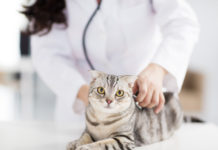Question: What is the purpose and name of the pocket fold of skin at the base of the outside edge of a cats ear?
Answer: Cats, dogs and many other mammals have these curious little pouches on the outer margin of their ear flaps. One of my veterinary anatomist friends here at Cornell informs me that the many folds and creases in the ears of his favorite animals, bats, play roles in echolocation (the sonar that bats use to locate objects in their environment), so its reasonable to assume that the many ridges, valleys, and folds in cats ear flaps probably help focus sounds down into cats ear canals to vibrate their ear drums. But the precise function of these little pockets remains obscure.
The ear flap, or pinna, is a reasonably simple looking structure, but like so many things in biology, the closer you look the more complex it gets. The flap is essentially a sandwich, with the inner and outer bread parts being skin and the meat part being made of thin, pliable cartilage designed to be moved about in complex fashion by muscles. There are multiple peaks, indentations, and bumps on the inner surface of the flaps, and each is given a descriptive – if you have a good working knowledge of Latin – name. To list only a few, names like scapha, helix, tragus, anthelix and antitragus. So something almost as curious as the fold itself is its relatively simple, good old English name: marginal cutaneous pouch (marginal, meaning at the margin; cutaneous, meaning skin; and pouch meaning…well, pouch). Go figure.
———-
Question: My-18 month-old cat has been eating very little and has no energy. My veterinarian has done several tests and all were within the normal range, except for a very high protein level in her blood. Additional tests are going to be done soon, but Im becoming very concerned, especially since she has lost one pound within four to five days. What causes a high protein level and what can be done? Is this life threatening?
Answer: An increase in the amount of protein molecules suspended in the liquid part of the blood (a condition called hyperproteinemia) has a number of causes, so we need to be systematic in the approach we take to determine the cause and significance. First, its important to know whether the elevation is real or just a result of laboratory error. Other substances in the blood, like fat or the contents of broken red blood cells, can confuse laboratory equipment and result in an erroneously increased reading for protein. Most laboratories notify veterinarians of the problem (using wording like serum is lipemic or sample is hemolyzed) to clue them into the problem, so this is probably not the case.
Relative or Absolute
We also need to make sure that the apparent hyperproteinemia isnt just due to dehydration (a condition called relative hyperproteinemia). Think about this for a moment: if a cat is dehydrated, then water gets drawn out of the blood leaving a higher concentration of protein – sort of the same way that one can boil soup to evaporate the water and make it thicker. Many sick cats become dehydrated so this is a real possibility, and I suspect that much of the body weight your cat lost in five days is water. We can usually determine whether the increased blood protein is due to dehydration by carefully evaluating accompanying blood test results. But if in doubt, we may simply correct the dehydration (by administering intravenous fluids, for example) to see whether the hyperproteinemia resolves once the cat is rehydrated.
If hyperproteinemia remains after rehydration – indicating true or absolute hyperproteinemia – your veterinarian may suggest submitting a blood sample to the laboratory for a serum protein electrophoresis, a test that determines exactly which of the many types of protein in the liquid part of the blood are elevated. The result can help lead to a diagnosis…but often times it wont. Why? Most commonly the test result will indicate a polyclonal gammopathy which can result from any number of inflammatory or infectious diseases (including bacterial, fungal, and viral infections like feline infectious peritonitis or FIP, or even some cancerous conditions) occurring anywhere in the body.
This doesnt narrow down the possibilities enough to be of much help. Rarely, though, the test will indicate a monoclonal gammopathy, a condition usually associated with cancer; such results, though not good news, will at least help to obtain a diagnosis.
Is This Life Threatening?
Sadly I cant tell you. It really depends on the underlying causes, and there are SO many possibilities. I encourage you to follow your veterinarians suggestions regarding further diagnostic testing, and I hope that all goes well for you and your kitty.



